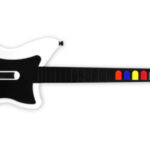Keeping your guitar in tune is the cornerstone of good playing. Whether you’re just starting your guitar journey or you’re a seasoned strummer, using a reliable Tuner For The Guitar is essential. Luckily, achieving perfect pitch has never been easier, especially with the advent of online guitar tuners. This guide will walk you through how to use a free online guitar tuner and offer expert tips to keep your instrument sounding its best.
Using an Online Guitar Tuner: A Step-by-Step Guide
Online guitar tuners are incredibly accessible and user-friendly, making them a fantastic tool for any guitarist. Here’s how to get started with a tuner for the guitar right here on guitarplayers.net:
Step 1: Activate the Tuner
To begin, you’ll need to activate the tuner by enabling microphone access.
- Simply click on the red microphone icon you see on the page.
- Your browser will then prompt you to grant permission for the website to use your microphone. Click “Allow” to proceed.
- This crucial step allows the tuner for the guitar to listen to your instrument and accurately detect the pitch of your strings.
Step 2: Check Your Guitar String’s Pitch
Before you start tuning, ensure you are in a quiet environment to minimize background noise, which can affect the tuner’s accuracy.
- Pick any string on your guitar to begin. Many guitarists find it easiest to start with the lowest string (the thickest one).
- As you play the string, the tuner for the guitar will instantly identify the note you are playing.
- You’ll see a visual slider appear on your screen, representing the pitch of your guitar string in real-time.
- A green slider indicates that your string is perfectly in tune.
- A red slider signals that the string is out of tune, and needs adjustment.
Step 3: Reading and Adjusting the Tuner
If the slider is red, indicating your guitar string is out of tune, it will be either flat or sharp. Understanding these terms is key to using your tuner for the guitar effectively.
String is Flat (Pitch Too Low)
- If the red slider appears to the LEFT of the center, it means your string is flat. This indicates the pitch is lower than it should be.
- To correct this, gently turn the tuning peg associated with that string counterclockwise. Keep plucking the string and watching the tuner until the slider turns green, indicating you’ve reached the correct pitch.
String is Sharp (Pitch Too High)
- Conversely, if the red slider is to the RIGHT of the center, your string is sharp. This means the pitch is higher than it should be.
- In this case, turn the tuning peg for that string clockwise. Again, continue to pluck the string and monitor the tuner until the slider turns green, confirming you are in tune.
Repeat this process for each string of your guitar, moving from string to string until all are showing green on your tuner for the guitar.
Essential Tips for Effective Guitar Tuning
- Explore Alternate Tunings: While the tuner for the guitar defaults to standard tuning (EADGBe), you can easily explore other tunings. Simply click on “standard” and choose from a variety of alternate tunings to experiment with different sounds.
- Tune Slowly and Deliberately: Avoid rushing when adjusting tuning pegs. Small, gradual twists are best to prevent overcorrection or, worse, snapping a string. Patience is key to precise tuning.
How Often Should You Use a Tuner for Your Guitar?
Regular tuning is crucial for maintaining the quality of your guitar’s sound and your playing experience. How often you need to reach for your tuner for the guitar depends on several factors:
- Playing Frequency: The more you play, the more often you’ll need to tune.
- Stringing Technique: Poorly strung guitars are more prone to going out of tune. Ensure your strings are correctly installed and stretched.
- Guitar Type: Some guitars, and even specific strings (like the G string on some Gibson models), are known to lose tune more readily.
- Environmental Factors: Temperature and humidity fluctuations can significantly affect tuning stability. Ideal conditions are between 66-77°F (19-25°C) and 40-50% humidity.
- Storage: Storing your guitar in a case offers better protection against environmental changes than leaving it out in the open.
As a general guideline, aim to tune your guitar every time you pick it up to play. Even a few minutes of playing can slightly alter the tuning. For longer playing sessions (30 minutes to an hour), check your tuning at least once during that time. If you’re performing live, make it a habit to tune every two to three songs to ensure a consistently polished sound.
For quick and easy access to a reliable tuner for the guitar, bookmark this page! Keep your guitar sounding its best and enjoy the music.


